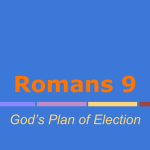In the last post I shared some of my thoughts on the sequence of events in salvation. I compared these events to a chemical reaction in which a person that is condemned to death is transformed into a person that is reconciled and made alive.
Dead & Condemned → Alive & Reconciled
This process is started when grace is applied, giving us the Grace Reaction.
The last post also presented the chain reaction as it is understood in Reformed theology. That reaction looks like this:
Dead → Grace → Regeneration → Faith → Justification → Reconciliation
Examining the equation above we were left with the question: is it possible for someone to be born again (regenerated) prior to having their sins forgiven (justification)?
While the various aspects of salvation occur faster than the combustion of methane/oxygen (see video in last post), it can be helpful to slow things down and evaluate the steps based on their logical order.
Faith and Justification
There is little debate that faith logically precedes justification. In Romans 4:1-5, Paul explains that Abraham was justified (credited as righteous) based on having faith. And in Romans 5:1 we read:
since we have been declared righteous by faith, we have peace with God (NET)
These passages give us some insight into the logical ordering of events. It affirms that justification (being declared righteous) is the result of faith. Furthermore, it tells us that the peace we have with God occurs after one has been justified. Digging into the Greek, the possession of peace (present indicative) is the main verb in the sentence. The act of being justified is an aorist participle. The participle (justification) can be translated as temporally occurring prior to the main verb (having peace) or the participle can be considered the cause of the main verb (see Wallace page 624,631).
The result is the following (partial) sequence of events:
Faith → Justification → Reconciliation (Peace)
This sequence seems to be supported by Colossians (1:20-22) which reminds us that peace and reconciliation is through the blood of Christ and His death on the cross. And it is on the cross that our debt was paid so that we might be justified (2:13).
Justification and Regeneration
That still leaves open the logical ordering of justification in relation to regeneration. The passage in Colossians (2:13-14) gives us some insight.
And you, who were dead in your trespasses and the uncircumcision of your flesh, God made alive together with him, having forgiven us all our trespasses, by canceling the record of debt that stood against us with its legal demands. This he set aside, nailing it to the cross.
Here the Greek is less clear. The main verb (made alive) and the participle (having forgiven) are both aorist. That means that temporally forgiveness (justification) occurs either prior to being made alive (regeneration) or these steps occur at the same time.
However, if regeneration and justification occur at the same time, and faith precedes justification then we still have faith logically occurring before regeneration.
Faith → Justification → Regeneration
Reading the text in Colossians presents a clear picture. It says that we are dead in our trespasses. The emphasis is placed on being made alive after our trespasses are removed. Our sins legally demand that we be condemned and considered dead. Once these legal demands are dealt with on the cross the path is made clear for God to make us alive.
Justification Transposition
We are dead in our transgressions (Eph 2:1; Col 2:13). The reason we are condemned is because we are guilty of having sinned against God. In different analogies sin is considered a debt that we owe (Col 2:13) or something we do that earns death (Rom 6:23). Jesus regularly taught that sin was comparable to a debt that cannot be paid back (Luke 7:40-50; Matthew 18:23-35).
The most sensible conclusion is that death, which is the penalty of sin, would be removed (by the giving of life) only after the issue (sin) causing the problem was dealt with.
Furthermore, if those who are born again (regenerated) are able to inherit the kingdom of God (John 3:3-5) and God can justly regenerate someone who is still weighed down by the debt of sin then why did He need to send Jesus to cancel out the debt?
The only way to balance the Reformed equation is to perform the Justification Transposition. To transpose something is to change the order, and to balance the equation we need to place justification prior to regeneration.
The ordo salutis as I have come to understand it can be represented by the following equation:
Dead → Grace → Faith → Justification → Reconciliation → Regeneration
Salvation is by Grace. Without God’s provision we would be left with our sin debt unpaid and would be condemned. The provision of grace does not mean the entire chain reaction will occur. Instead this grace makes the reaction possible by convicting, illuminating, and enabling a person to respond in faith. But there is still the faith variable. A person might accept the gracious gift of salvation, providing a catalyst that propels the reaction forward. Sadly a person might reject salvation. This acts as an inhibitor stopping the Grace Reaction from going forward. A person has a part to play in salvation, but the reaction that transforms the dead to life is all about grace and the work of God. It is God that loves, providing a way to save us. It is God that justifies, reconciles, and regenerates. There is nothing to boast about. May we boast then in the cross and let God have the Glory!
Note: This post originally appeared as The Justification Transposition at DeadHeroesDontSave.com – comments can be added on that page.





